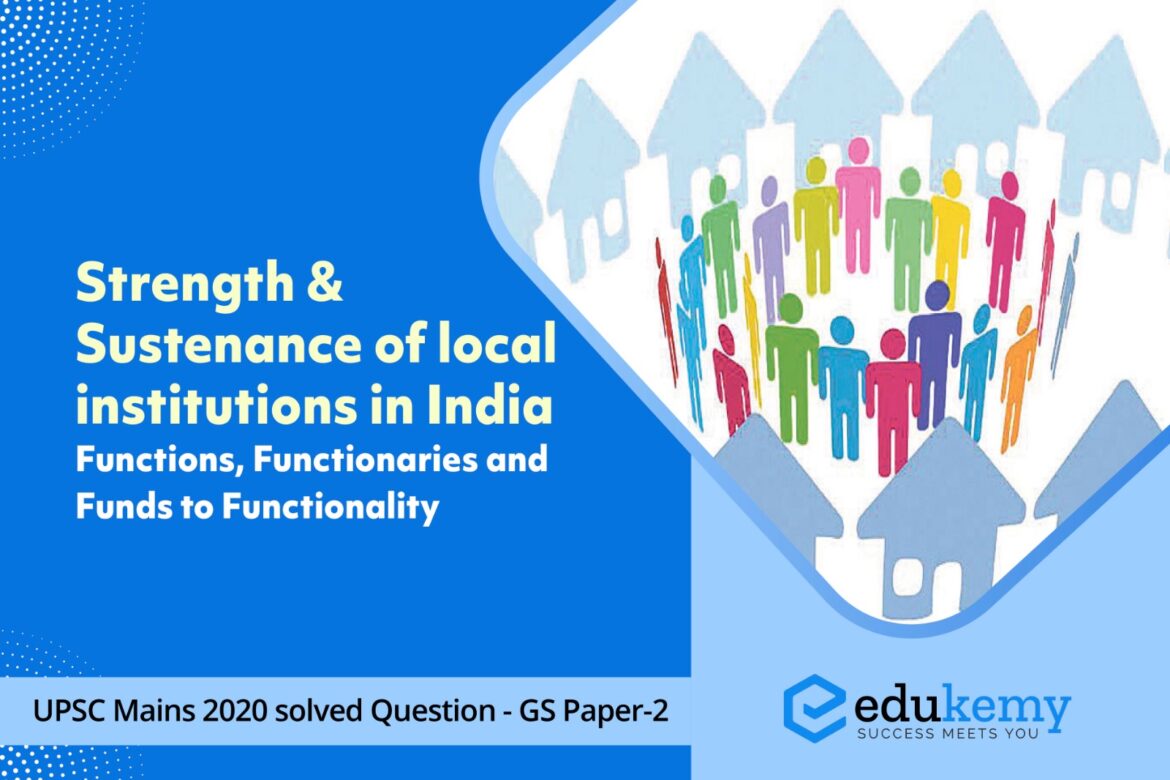The evolution of local institutions in India has witnessed a transformative journey from their foundational triad of ‘Functions, Functionaries, and Funds’ to the current emphasis on ‘Functionality.’ While these institutions, such as Panchayati Raj institutions, municipal bodies, and local governance structures, have made significant strides in terms of their roles, personnel, and financial autonomy, they now grapple with critical challenges in ensuring their continued functionality. One major hurdle is the issue of capacity building, where local functionaries often face a lack of training and resources to effectively discharge their responsibilities. Additionally, the phenomenon of politicization poses a threat to the autonomy of these institutions, hindering their ability to address local issues impartially. Financial sustainability is another pressing concern, as local bodies struggle to generate adequate funds for developmental initiatives. The need for greater public participation and awareness further compounds these challenges, as the success of local institutions relies heavily on the active involvement and support of the local populace. Therefore, navigating these obstacles is essential to uphold the functionality of local institutions and ensure their continued strength and sustenance in the Indian governance framework.
UPSC Mains General Studies Paper – 2 Mains 2020
Functions and responsibilities of the Union and the States, issues and challenges pertaining to the federal structure, devolution of powers and finances up to local levels and challenges therein
UPSC Mains Civil Services IAS Exam Question Paper – 2020
Contents
- 1 Structure of the Question
- 2 Answer
- 3 Conclusion
- 4 Frequently Asked Questions (FAQs)
- 4.1 1. What is the significance of the shift from the formative phase of ‘Functions, Functionaries, and Funds’ to the contemporary stage of ‘Functionality’ in local institutions in India?
- 4.2 2. What are the critical challenges that local institutions in India face in terms of their functionality in the present context?
- 4.3 3. How has the decentralization of power influenced the functionality of local institutions in India, and what challenges has it presented?
- 4.4 4. In what ways do financial constraints impact the functionality of local institutions in India, and what measures can be taken to address these constraints?
- 4.5 5. How do changing societal dynamics and technological advancements affect the functionality of local institutions, and what strategies can be adopted to adapt to these changes?
Structure of the Question
- In Introduction,
- Try to write about the Formative Years of Local Institutions.
- In Body,
- Challenges to the functionality of Local Institutions in India.
- Measures to Strengthen Local Institutions.
- In Conclusion, try to comment on the need to strengthen Local Institutions.
Answer
Introduction
“When the panchayat raj is established, public opinion will do what violence can never do.” – Mahatma Gandhi
To increase democratic decentralization, Panchayati Raj Institutions and Urban Local Governments were set up through the 73rd & 74th Amendment Acts. Today in 2021, many issues have rendered the 3rd tier of government in a state where it has more responsibility but less power and resources. While traditional challenges in terms of funds, functions, and functionaries (3Fs) remain quite relevant even today, we cannot lose sight of challenges being faced in terms of “functionality”.
Formative Years of Local Institutions
- Balwant Rai Mehta Committee in 1957, reviewed the working of the CDP and suggested three-tier PRIs, namely, Gram Panchayats at the village level, Panchayat Samiti at the block level, and Zilla Parishad at the district level.
- Ashok Mehta Committee in 1977, recommended compulsory power of taxation.
- GVK Rao Committee in 1985, recommended assigning a role concerning planning, implementation, and monitoring of rural development programs.
- The Gadgil Committee in 1988, made comprehensive recommendations on Local institutions. Based on its recommendations, 73rd and 74th Constitutional amendments were passed which suggested:
- Gram Sabha as the foundation of the Panchayati Raj System.
- Three-tier system for local government and assigned them constitutional status.
- Direct election by people of all members of local bodies and reservation of seats for SC/ST and women at all three levels.
- State Election Commission for supervision of the elections.
- Formation of the State Finance Commission every five years for reviewing the financial provisions of local bodies.
Challenges to the Functionality of Local Institutions
- Structural Deficiencies: PRIs suffer from structural deficiencies i.e. inadequate secretarial support and lower levels of technical knowledge which restrict the aggregation of bottom-up planning.
- Emergence of Parallel Governance System at Local Level: Suppose a Special purpose vehicle for the execution of the city development under the Smart Cities Mission. Thus, creating a parallel institution vis-a-vis Urban local government. o This functional overlapping may eventually lead to the weakening of local bodies.
- Top-Down Approach: NITI Aayog’s Aspirational District plan envisages top-down development of these districts, which not only undermines the role of local governments but also goes against the spirit of Democratic decentralization. The one-size-fits-all approach also affects the functionality of local governments.
- Limited Reach: The state governments have yet to delegate the actual functional autonomy excluding Kerala, Karnataka, Madhya Pradesh, etc., as most states have conformed to the 73rd and 74th Constitutional Amendment Acts only on paper.
- Proxy Representation: Though women and SCs/STs have got representation in PRIs through reservation mandated by the 73rd amendment, proxy representation, for example, in the case of women through Panch-Pati, acts as a major hurdle.
- Structural Issues: Some of the Gram panchayats or urban local governments do not have their own building or they exist without basic facilities like toilets, drinking water, and electricity connection. o Moreover, there is a lack of support staff and personnel in local bodies such as secretaries, junior engineers, computer operators, and data entry operators, affecting their functioning and delivery of services.
- Funding: Functionality is dependent on financial aid but there have been issues with the implementation because local institutions are excessively dependent on the government for funding and lack their revenue-generating mechanisms through local taxes and receiving intergovernmental transfers.
- Corruption: Local bodies are marred by corruption. Due to this, local bodies are not able to function properly which subsequently affects the development process.
Measures to Strengthen Local Institutions
- Government Programmes being merged: Convergence of various development programs could prove to be beneficial. In this context, Mission Antyodaya is a step in the right direction.
- Activity Mapping: The 2nd ARC had recommended that there should be a clear-cut demarcation of functions of each tier of the government.
- Effective Auditing: Audit committees may be constituted by the State Governments at the district level to inspect the integrity of financial information, ethical conduct of all persons involved in local bodies, fairness of internal controls, and compliance with the applicable laws.
- Eg: The initiative of the Meghalaya government to make social auditing mandatory is a great step in this pursuit.
- Ensuring Fiscal Federalism: As functionality also depends on finances, fiscal autonomy accompanied by fiscal accountability can provide a long-term solution to the problems faced by local bodies.
- Recruiting and Training Personnel: Recruiting efficient personnel with the necessary qualifications and providing capacity building could result in better functioning of the system.

Conclusion
Local institutions have been able to strengthen democracy at the root level. But as the institutions have evolved, new challenges have emerged. Their rectification will require raising awareness among the masses and their representatives, clear demarcation of responsibility, and a system of accountability. The fulfillment of the purpose of the 73rd Constitutional Amendment Act will lead to Atmanirbhar Panchayats which in turn would help realize the goal of Atmanirbhar Bharat.
Read our Solved Papers.
Frequently Asked Questions (FAQs)
1. What is the significance of the shift from the formative phase of ‘Functions, Functionaries, and Funds’ to the contemporary stage of ‘Functionality’ in local institutions in India?
This shift underscores the evolution of local institutions from mere bureaucratic entities to dynamic and effective bodies. The focus on ‘Functionality’ highlights the imperative for these institutions to not only perform assigned functions but also to do so efficiently and responsively. Understanding this transition is crucial for grasping the changing role and expectations placed upon local institutions.
2. What are the critical challenges that local institutions in India face in terms of their functionality in the present context?
Local institutions encounter multifaceted challenges in maintaining their functionality. Issues such as bureaucratic red tape, inadequate resources, and outdated administrative structures pose significant hurdles. Additionally, ensuring inclusivity, transparency, and responsiveness to the diverse needs of the local populace emerges as a persistent challenge in enhancing the overall functionality of these institutions.
3. How has the decentralization of power influenced the functionality of local institutions in India, and what challenges has it presented?
The decentralization of power has empowered local institutions, but it has also introduced challenges. Striking the right balance between autonomy and accountability remains a delicate task. Challenges arise in terms of capacity building at the local level, ensuring uniformity in service delivery, and preventing the misuse of decentralized powers. Understanding the nuances of this shift is essential in addressing the challenges faced by local institutions.
4. In what ways do financial constraints impact the functionality of local institutions in India, and what measures can be taken to address these constraints?
Financial constraints pose a severe threat to the functionality of local institutions. Limited funds often lead to compromised services and hinder developmental initiatives. Exploring sustainable financial models, promoting fiscal decentralization, and advocating for increased budget allocations are essential steps to alleviate these challenges and enhance the financial resilience of local institutions.
5. How do changing societal dynamics and technological advancements affect the functionality of local institutions, and what strategies can be adopted to adapt to these changes?
The rapid pace of societal changes and technological advancements has a profound impact on the functionality of local institutions. Adapting to new communication channels, leveraging technology for efficient service delivery, and addressing emerging social issues are critical. Strategies involving continuous training, embracing innovation, and fostering collaboration between local institutions and technology experts are imperative to ensure they remain relevant and effective in the face of evolving challenges.

For UPSC Prelims Resources, Click here
For Daily Updates and Study Material:
Join our Telegram Channel – Edukemy for IAS
- 1. Learn through Videos – here
- 2. Be Exam Ready by Practicing Daily MCQs – here
- 3. Daily Newsletter – Get all your Current Affairs Covered – here
- 4. Mains Answer Writing Practice – here
Visit our YouTube Channel – here


